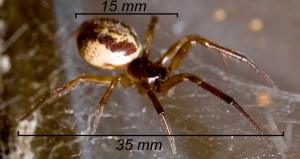 So, what does a false widow spider look like? As the name suggests this little beasty bears some resemblance to the infamous black widow spider. However, on closer inspection the false widow does not have the jett black colouring of its notorious cousin and red markings are swapped for cream markings on the abdomen.
So, what does a false widow spider look like? As the name suggests this little beasty bears some resemblance to the infamous black widow spider. However, on closer inspection the false widow does not have the jett black colouring of its notorious cousin and red markings are swapped for cream markings on the abdomen.
Identifying the False Widow Spider
- The false widow is a medium sized spider, approximately the size of a 50 pence piece. The body ranges from around 7mm to 15mm in length and the leg span reaches up to 35mm.
- The body and legs have a glossy appearance.
- The thorax and legs are a dark / orangey brown colour, unlike the pitch black of the true widow spiders.
- The abdomen is fairly bulbous with cream patterning on top. It is said that these markings resemble a skull in S. nobilis.
The spider can also be identified by its behaviour and environment:
- False widows are largely nocturnal, spending the day hidden away in a deep crack or hole adjoining its web.
- False widows like dry, relatively warm environments where they are not likely to be disturbed. This inevitably brings them indoors and they are most often seen in sheds or outbuildings.
Interestingly, these spiders seem to have a preference for south facing walls. - The web is an irregular tangle of fine, sticky silk fibres of high strength. The spider will spend its evenings upside down in this web.
There are a number of other native British spiders that are commonly confused with false widows. Further information on these can be found on the mistaken for false widow spider page
Questions:
Are FWs a serious danger?
How did they arrive in the UK, and from where?
As they are not indigenous here, does our climate suit them?
Can they be exterminated? Would it be wise?
Are false widows also found in California?